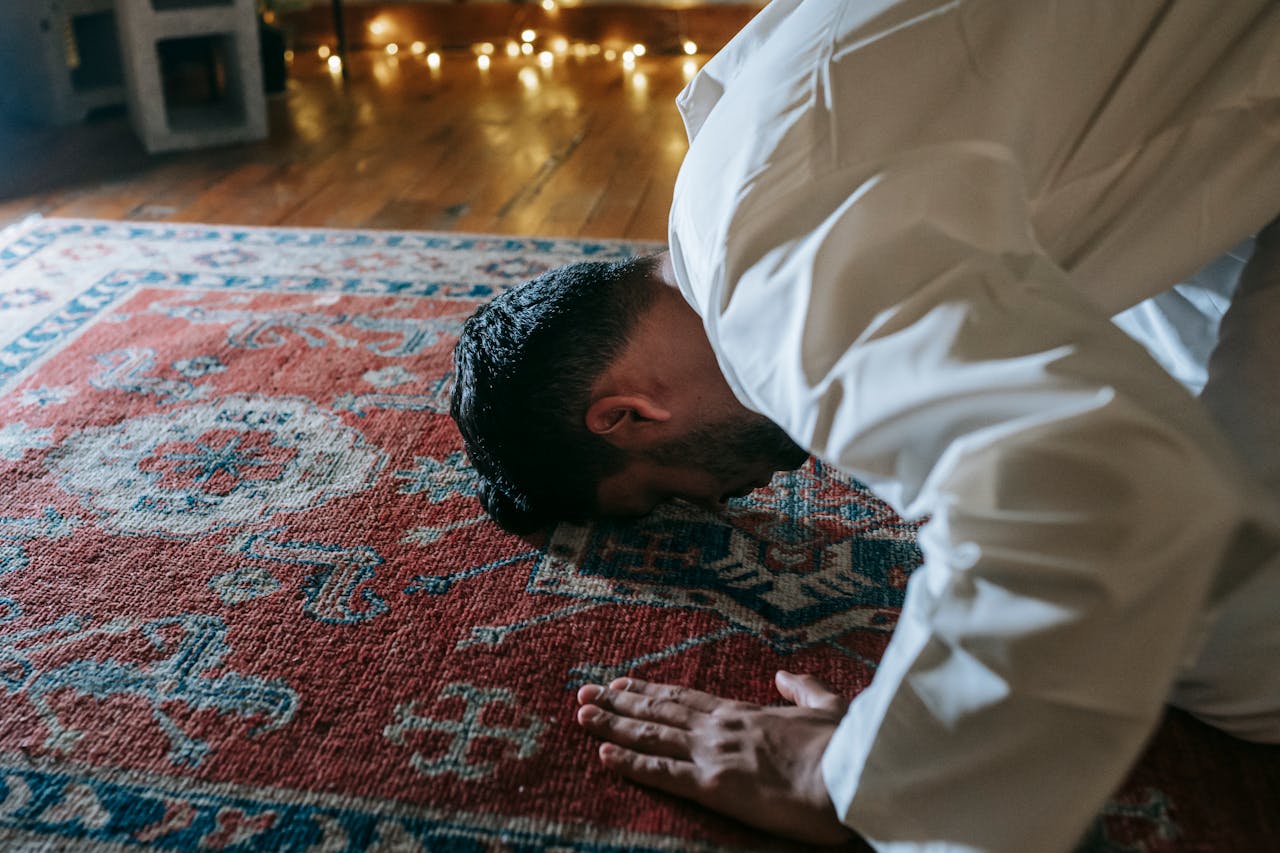“So glory be to Allah when you enter the night (i.e., offer the Maghrib and Ishâ night prayers) and when you enter the morning (i.e., offer the Fajr prayer).”
“And worship Him (a portion) of the night (i.e., the offering of Maghrib and Ishâ prayers) . And glorify Him through the livelong night (i.e., the Tahajjud prayer).”
The Maghrib prayer, also known as the sunset prayer, is the prayer that Muslims perform between the Asr prayer and the Isha prayer. According to the Islamic calendar, the Maghrib prayer marks the beginning of a new day and is, hence, the first prayer of the day. The word Maghrib is derived from the Arabic language and means sunset, thus the name of the prayer.
The Rakats Of Maghrib Prayer
The Maghrib prayer consists of the following rakats:
- 3 Fard Rakats
- 2 Sunnah Rakats
- 2 Nafl Rakats
All of these rakats of the Maghrib prayer hold immense significance. Even though there are only three fard rakats in the Maghrib prayer, one should strive to perform all rakats in the given order because:
“On Qayamah (the Day of Judgement), if there are any deficiencies in a person’s obligatory prayers, Allah will ask his angels to see if there are any sunnah prayers performed by the person. And if there are any sunnah prayers, they will be used to make up for the shortcomings in the obligatory prayers.” [Sunan Abi Dawud, 864]
Aisha (RA) reported that the Messenger of Allah (PBUH) said “Anyone who consistently performs twelve units (Rak’ah) of Sunnah prayers will have a house constructed for them in Paradise. These units consist of four Rak’ah before the Zuhr prayer, two Rak’ah after it, two Rak’ah after Maghrib, two Rak’ah after ‘Isha’, and two Rak’ah before Fajr.”
And, although the last rakats of the Maghrib prayer are Nafl rakats, performing them brings numerous blessings and strengthens one’s relationship with the Lord. But if the time for prayer is coming to an end, one should always first pray the fard rakats, then the sunnah, and then the nafl rakats.
Why The Maghrib Prayer?
The Maghrib prayer has a profound impact on a Muslim’s life. It marks the transition from day to night and allows one to reflect on the whole day. Furthermore, it provides a perfect opportunity to relax and turn to Allah SWT to calm the heart. It helps to center the mind and spirit and serves as a reminder that no matter what one is going through, Allah SWT is always by their side. Additionally, the Maghrib prayer gives one an opportunity to enter the nighttime with blessings and guidance, ensuring that the day is centered around worship and the remembrance of the Lord.
The Time Of Maghrib Prayer
The Prophet PBUH said that “the time for Maghrib is until the twilight has dissipated.”
In his renowned work “Fiqh As-Sunnah,” Sheikh Sayyid Sabiq provides a detailed explanation of this: the time of the Maghrib prayer is when the sun has set, and it lasts until the red twilight ends. An-Nawawi, in his commentary on Sahih Muslim, stated that research scholars believe it is permissible to delay the Maghrib prayer as long as twilight remains. It is allowed to begin the prayer at any time during the mentioned period.
Praying Maghrib At The Earliest
Abu Najashi reported that he heard Rafi’ bin Khadij mention that “During the time of the Messenger of Allah, they would perform the Maghrib prayer, and the sky still had so much light that one could see where their arrows landed when shot from a bow.”
This hadith clearly emphasizes that the Prophet PBUH used to pray Maghrib at the earliest. It is also greatly preferred to perform the Maghrib prayer as early as one can because, in another hadith, the Prophet PBUH stated that his ummah will continue to adhere to the fitrah (or prosper) as long as they pray the Maghrib prayer before the stars make an appearance. [Sunan Ibn Majah, 689]
Combining The Prayers
Several narrations state the Prophet PBUH combining prayers, such as:
“Mu’adh bin Jabal narrated that “During the Battle of Tabuk, the Prophet (PBUH) would adjust the timing of his prayers based on his departure. If he aimed to leave before Maghrib, he would postpone Maghrib and pray it together with Isha. However, if he was leaving after Maghrib, he would move Isha forward so that he could pray it alongside Maghrib.” [Jami` at-Tirmidhi 553]
Ibn ‘Umar reported that “The Messenger of Allah (PBUH) combined the Maghrib (sunset) and ‘Isha’ prayers at Muzdalifa. He performed three Rak’ahs for the Maghrib prayer and two Rak’ahs for the ‘Isha’ prayer, all with a single Iqamah.” [Sahih Muslim 1288d]
Zaid bin Aslam narrated from his father that “While he was traveling to Mecca with Ibn ‘Umar, he received news that Safiya bint Abu Ubaid was critically ill. This prompted him to quicken his pace. When twilight faded, he dismounted and prayed the Maghrib and Isha prayers together. He then remarked that he observed the Prophet (PBUH) doing the same whenever he needed to hurry while traveling, by delaying the Maghrib prayer and combining it with the ‘Isha’ prayer.” [Sahih al-Bukhari, 1805]
Apart from the journey, the Shariah permits Muslims to combine their prayers for other reasons.
- A traveler can combine prayers as long as his journey is not disliked or prohibited.
- If a sick person who faces hardship and turmoil doesn’t join his prayers, he can combine them more easily to fulfill his spiritual obligations.
- A woman who is suffering from Istihadah (irregular bleeding) can combine her prayers because Istihadah is also considered a form of sickness.
- A person who can’t work out the time, such as a blind or underground person.
- A person who is unable to purify or to Tayammum for every prayer.
- A person who constantly suffers from nosebleeds.
- A person who is incontinent and constantly passes urine or Madhy.
- For someone who is breastfeeding, the difficulty arises from managing frequent impurities, making it challenging to purify oneself for every prayer.
- One who has a legitimate reason that makes it permissible not to pray Jum’ah and prayers in congregation, such as one who fears for his life or his wealth.
Note: According to Islamic law, the combined prayers can be prayed at either the time of the Maghrib prayer or the time of the Isha prayer. Praying them at another time is not permissible.
Other Reasons for Combining Maghrib and Isha Only
Apart from the scenarios mentioned above, there are other circumstances in which Muslims are allowed to join the Maghrib and Isha prayers together.
- In the event of rain, a Muslim’s clothes, shoes, and body are soaked, and thus causes hardship.
- In the event of snow or hail, they come under the same rule as rain.
- When there is ice due to extreme cold.
- In the case of mud and intense cold wind, which causes hardship.


Can you make a little more clearer how many rakhs are prayed in combined prayers for magrib and isha? JazakAllah
Maghrib Salah consists of three rakats, which is a unique part of our daily prayers. It’s a time for reflection and gratitude as the day comes to an end. If you’re looking to deepen your spiritual practice, I also recommend reading Surah Yaseen. Known as the heart of the Quran, it offers beautiful lessons and comfort. You can easily find a Surah Yaseen PDF online to read and reflect on its profound meanings!